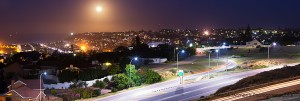There was a lot of hype and media articles all over Facebook regarding the ‘Super moon’ of the 23rd June 2013. The moon was supposed to appear 13% larger than a normal full moon and for that reason hotspots for moon photography saw more tripods being put up than ever before for a full moon.
In reality the difference could not really be measured by the naked eye although we would all like to believe that the difference was clearly visible….come on…admit it…it didn’t really appear that much bigger.
Well I confess that I was one of those that went out to put up my tripod with the hope that I would be able to capture a worthy ‘Supermoon’. My main idea was to try and capture a panoramic image of Mossel Bay with the full moon rising over the hill that is Mossel Bay. I found an elevated spot and set up and composed.
We waited a while and then waited another while for the first glimpse of the rising moon. I made us of Aperture priority to make sure of my depth of field in the shot. I was not going for one of those “wow look how big the moon is compared to the houses look”. I wanted the town as a whole under the moon. Granted I did take some of those ‘big moon shots’ but they are not worth posting. Use a long lens for this…at least 200mm, preferably 300mm and more.
Some other things to remember when ‘Shooting the moon’.
- Use a tripod – Without a tripod you won’t getting a steady shot if you incorporate landscape with the moon.
- Use your timer or shutter release – Any physical contact will cause vibrations in your camera and bring about blurred images.
- The moon gets it light from the sun – Just because it is night does not mean your exposure has to be long. Long exposures will just blow out the moon and any detail your are trying to capture. I have seen that shutter speeds of around 1/125 – 1/250 at ISO100 and f11 usually give good results. Don’t take my word for it however…experiment.
Good luck on your next full moon shooting expedition.
I leave you with an image take last night.
